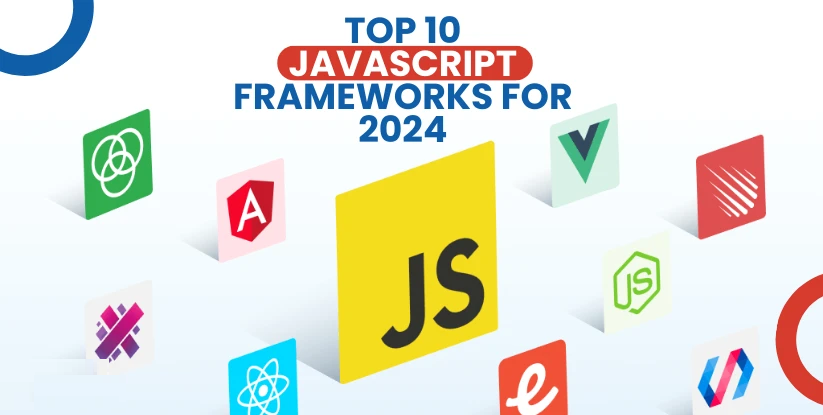In 2024, the world of web development continues to evolve at a rapid pace, and JavaScript remains a cornerstone of modern web development. JavaScript frameworks have played a crucial role in simplifying development, improving efficiency, and enhancing the overall user experience. As you embark on your web development journey in 2024, it’s important to choose the right JavaScript framework to meet your project’s requirements. In this article, we’ll explore some of the best JavaScript frameworks to consider in 2024, highlighting their features, use cases, and advantages.
Best JavaScript Frameworks to Choose in 2024
1. React
React, developed and maintained by Facebook, has consistently been one of the most popular JavaScript Frameworks for building user interfaces. Its component-based architecture makes it easy to create reusable UI components, making development more efficient and maintainable. React’s virtual DOM and one-way data binding provide excellent performance, making it suitable for building dynamic and responsive web applications.
Key Features:
- Component-based architecture
- Virtual DOM for efficient updates
- Strong community and ecosystem
- Excellent performance
- Server-side rendering support
Use Cases: React is ideal for building single-page applications (SPAs), progressive web apps (PWAs), e-commerce websites, and complex user interfaces where real-time updates and interactivity are crucial.
2. Vue.js
Vue.js is a progressive JavaScript framework known for its simplicity and ease of integration. It allows developers to incrementally adopt its features, making it suitable for both small and large projects. Vue’s two-way data binding and component system simplify UI development. It has gained popularity due to its gentle learning curve and comprehensive documentation.
Key Features:
- Progressive Framework
- Two-way data binding
- Simple and flexible syntax
- Strong developer community
- Detailed documentation
Use Cases: Vue.js is well-suited for building web applications of varying complexity, from simple prototypes to large-scale applications. It is particularly popular among startups and small to medium-sized businesses.
3. Angular
Angular, maintained by Google, is a comprehensive and opinionated JavaScript framework. It provides a complete ecosystem for building web applications, including powerful tools for routing, forms, and state management. Angular’s use of TypeScript ensures strong typing and enhanced code quality. While it has a steeper learning curve compared to some other frameworks, Angular offers robust features for large and complex projects.
Key Features:
- Comprehensive framework with a rich ecosystem
- Strongly typed with TypeScript
- Powerful CLI (Command Line Interface)
- Dependency injection system
- End-to-end testing support
Use Cases: Angular is an excellent choice for building enterprise-level applications, large-scale projects, and applications with complex data manipulation and state management requirements.
4. Svelte
Svelte is a relatively new JavaScript framework that takes a different approach to web development. Instead of running in the browser like traditional frameworks, Svelte compiles components into highly efficient JavaScript during the build process. This results in faster load times and better performance. Svelte’s simplicity and small bundle sizes make it an attractive choice for developers.
Key Features:
- Compiler-based framework
- Minimal runtime overhead
- Simple and expressive syntax
- Small bundle sizes
- Seamless integration with other JavaScript libraries
Use Cases: Svelte is suitable for building lightweight web applications, interactive widgets, and projects where performance is a top priority.
5. Ember.js
Ember.js is a full-featured JavaScript framework that provides strong conventions and a set of tools for building ambitious web applications. It offers a well-defined project structure, data layer, and powerful templating system. Ember’s focus on convention over configuration can speed up development and maintenance.
Key Features:
- Convention over configuration
- Strong opinions and project structure
- Ember CLI for project management
- Ember Data for data management
- Comprehensive testing tools
Use Cases: Ember.js is a good fit for large-scale web applications, content management systems, and projects where consistency and maintainability are paramount.
6. Meteor
Meteor is a full-stack JavaScript framework that simplifies both front-end and back-end development. It provides real-time data synchronization, allowing you to build responsive and collaborative web applications effortlessly. Meteor’s isomorphic architecture enables code sharing between the client and server, reducing redundancy.
Key Features:
- Full-stack framework
- Real-time data synchronization
- Isomorphic architecture
- Large package ecosystem
- Built-in support for modern JavaScript (ES6+)
Use Cases: Meteor is well-suited for real-time collaborative applications, social networks, chat applications, and projects that require a unified front-end and back-end development experience.
7. Next.js and Nuxt.js
While not traditional frameworks, Next.js (for React) and Nuxt.js (for Vue.js) are powerful frameworks for server-side rendering (SSR) and static site generation (SSG). They provide excellent performance and SEO benefits by pre-rendering pages on the server.
Key Features:
- Server-side rendering (Next.js) and static site generation (Nuxt.js)
- Routing and navigation system
- Automatic code splitting
- SEO-friendly by default
- Strong developer communities
Use Cases: Next.js and Nuxt.js are ideal for building content-heavy websites, blogs, e-commerce platforms, and applications where SEO and performance are critical.
8. Express.js
Express.js is a minimal and flexible Node.js web application framework known for its simplicity and speed. While not a full-fledged front-end framework like the others mentioned, Express is a popular choice for building back-end APIs and servers.
Key Features:
- Lightweight and fast
- Robust routing system
- Middleware support
- Large ecosystem of middleware packages
- Ideal for building RESTful APIs
Use Cases: Express.js is commonly used to build RESTful APIs, server-side applications, and microservices that serve as back-ends for various front-end frameworks.
9. Aurelia
Aurelia is a modern JavaScript framework designed with simplicity and extensibility in mind. It offers a modular and unobtrusive approach to building web applications. Aurelia’s code is easy to understand, and it allows you to use your preferred libraries and tools.
Key Features:
- Modular architecture
- Two-way data binding
- Extensible and pluggable
- Clean and intuitive syntax
- Strong developer community
Use Cases: Aurelia is a solid choice for developers who prefer a lightweight and flexible framework for building web applications, especially when integrating with existing projects.
10. Mithril
Mithril is a lightweight JavaScript framework focused on simplicity and performance. It is designed to have a small footprint and minimal overhead. Despite its size, Mithril provides a robust set of features for building modern web applications.
Key Features:
- Small bundle size
- Virtual DOM for efficient updates
- Simple and concise API
- Fast rendering performance
- Ideal for single-page applications (SPAs)
Use Cases: Mithril is a great choice for developers looking for a fast and lightweight framework for building SPAs and applications where minimalism and speed are priorities.
Choosing the Right Framework
When selecting a JavaScript framework in 2024, consider your project’s specific requirements and your team’s expertise. Each framework has its strengths and weaknesses, and the best choice depends on factors like project size, complexity, performance needs, and familiarity with the technology.
It’s also worth noting that the JavaScript ecosystem is dynamic, and new frameworks and updates to existing ones may emerge throughout the year. Staying up to date with the latest developments and community trends can help you make informed decisions when choosing a framework for your web development projects.




